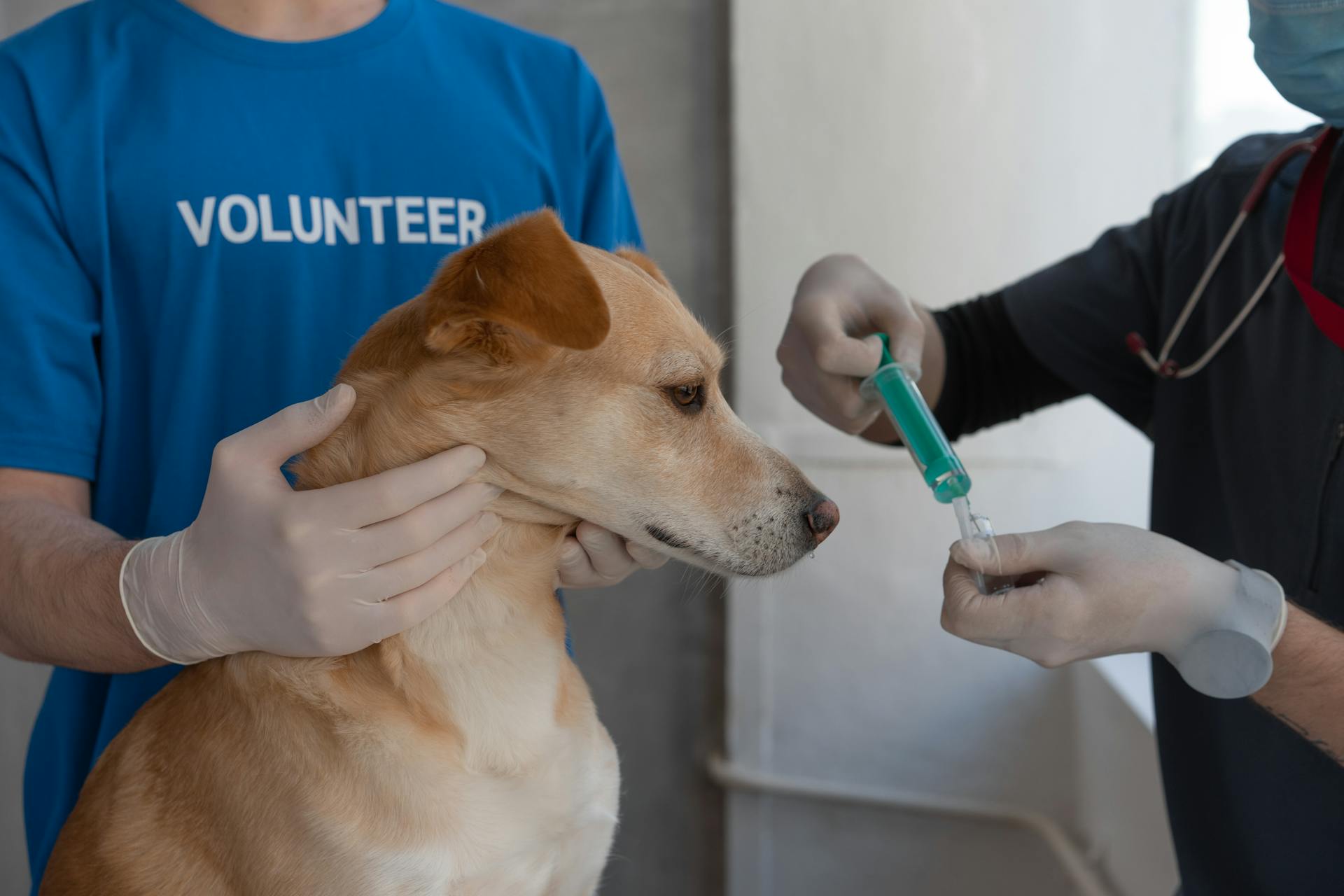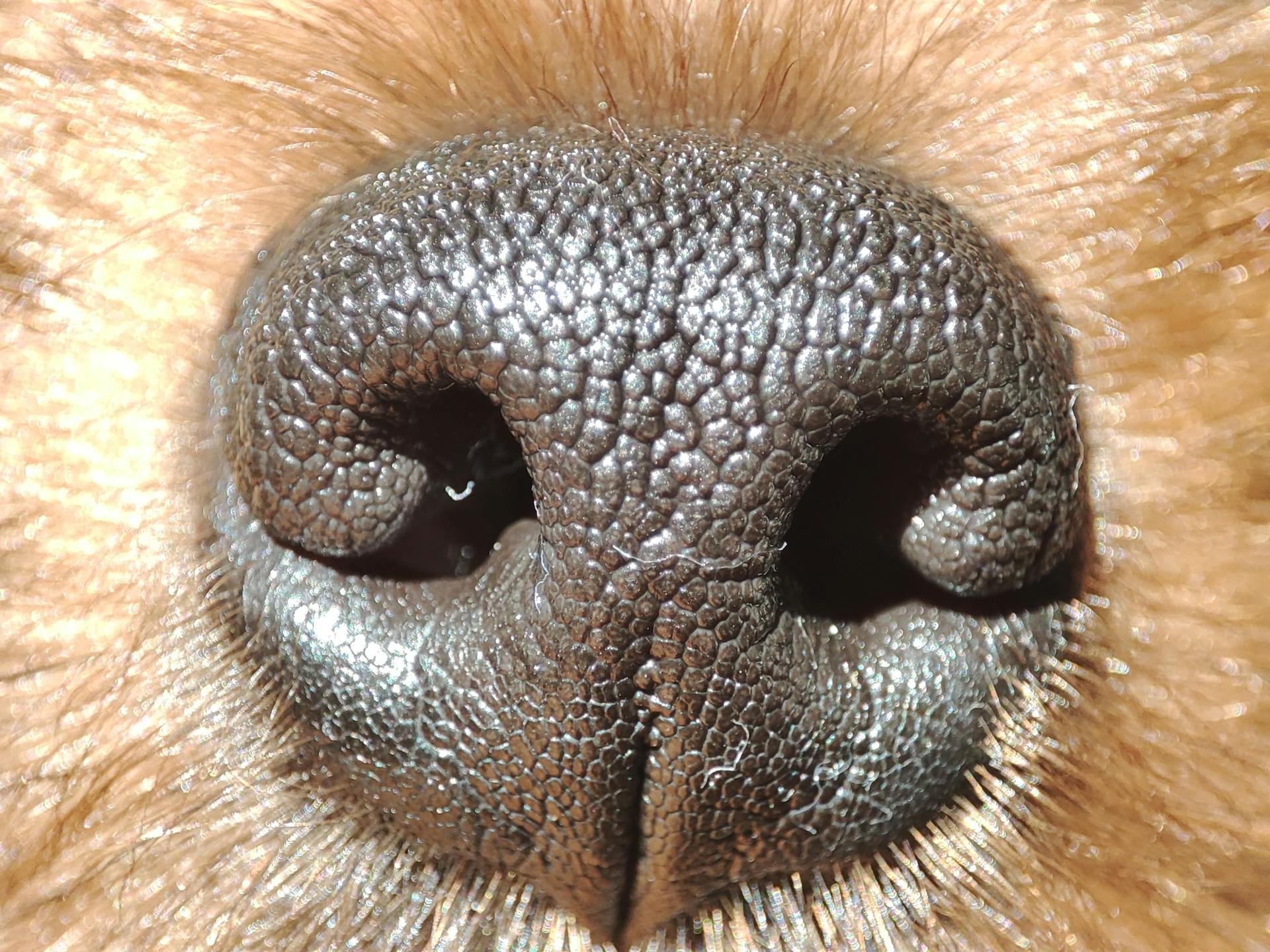
Dog flea collars are a popular solution for controlling flea infestations in dogs, but like any medication or product, they can have side effects.
Some common side effects of dog flea collars include skin irritation, redness, and itching at the site of application.
Flea collars can also cause vomiting, diarrhea, and lethargy in some dogs.
In severe cases, flea collars have been linked to seizures and tremors in dogs.
It's essential to monitor your dog's behavior and health after applying a flea collar, as some side effects may not be immediately noticeable.
Common Side Effects
Skin irritation is a common side effect of flea collars, usually caused by the materials they're made of or the chemicals used in them. This can lead to allergic reactions or minor rashes in some cases.
To reduce your dog's risk of skin problems, look for collars made from natural materials and use gentle formulas that don't contain strong pesticides or other harsh chemicals. A well-fitting collar is also essential to prevent discomfort and irritation.
Allergic reactions can occur due to prolonged exposure to insecticides in flea collars, leading to symptoms like itching, swelling, hives, rashes, or difficulty breathing. If you experience any of these signs, seek medical attention right away.
Here are some potential side effects to be aware of:
- Skin irritation and rashes
- Allergic reactions, including itching, swelling, and hives
- Difficulty breathing
- Neurologic adverse reactions, such as muscle tremors, ataxia, and seizures (although rare)
Allergic Reactions
Allergic Reactions can be a common issue with flea collars, manifesting as itching, swelling, hives, rashes, or even difficulty breathing. If you experience any of these symptoms, it's crucial to seek medical attention right away.
Some flea collars use insecticides to kill off fleas and their larvae, which can cause human bodies to become sensitized to the insecticide due to prolonged exposure. This sensitivity can result in allergic reactions and contact dermatitis on the areas of skin coming into contact with the collar.
Mild allergic reactions are typically uncomfortable and can cause skin irritation or redness. However, if left untreated, severe allergies can be dangerous.
Flea collars made from natural materials and gentle formulas can reduce the risk of allergic reactions. However, it's still essential to monitor your pet for any signs of irritation, such as excessive scratching, redness, or rashes, after wearing their flea collar.
Check this out: Can Peanut Butter Cause Pancreatitis in Dogs
What to Know

Isoxazoline products, commonly used to prevent flea and tick infestations in dogs and cats, have been associated with neurologic adverse reactions.
These reactions can include muscle tremors, ataxia, and seizures in some animals. Most dogs and cats won't experience these adverse reactions, but seizures can occur in animals without a prior history.
The FDA considers isoxazoline products safe and effective, but they're providing this information to help pet owners and veterinarians make informed decisions about flea and tick prevention.
If you suspect your pet is experiencing an adverse event while using an isoxazoline product, consult your veterinarian first.
The FDA encourages pet owners and veterinarians to report adverse drug events, which can be done by contacting the manufacturer or submitting a report directly to the FDA.
Here are the phone numbers for the manufacturers of isoxazoline products: Insert phone numbers here
You can also contact the FDA directly at [email protected] or call 240-402-7002 for additional information about adverse drug experience reporting for animal drugs.
A unique perspective: Can Cat Food Cause Seizures in Dogs
Serious Risks
Flea collars can be very effective, but they also come with serious risks.
Flea collars contain powerful chemicals that can cause nausea, vomiting, convulsions, headaches, seizures, dizziness, confusion, and loss of consciousness if ingested or absorbed through the skin.
These chemicals are related to nerve agents like sarin gas, which is a scary thought.
In addition to toxicity, flea collars can also cause skin irritation or allergic reactions, depending on the type of collar being used.
If you're considering using a flea collar, make sure to follow instructions carefully and research online from reliable sources to minimize the risk of adverse effects.
Seresto Collar Safety
Seresto's Flea and Tick Collar has been linked to nearly 1,700 pet deaths.
To report suspected adverse drug events, contact the manufacturers at the following phone numbers.
TCVP in Flea and Tick Pet Products
The TCVP in Flea and Tick Pet Products is a concerning topic, especially when it comes to Seresto Collar Safety.
TCVP, or tetrachlorvinphos, is a pesticide used in some flea and tick products, including Seresto Collars.
Seresto Collars contain TCVP, which is a toxic substance that can harm cats and other non-target animals.
The EPA has received reports of TCVP-related incidents, including animal deaths and illnesses.
The use of TCVP in flea and tick products has been linked to various health problems in pets, including neurological damage and even death.
If you're using a Seresto Collar, it's essential to follow the manufacturer's instructions carefully to minimize the risk of TCVP exposure.
Explore further: Seresto Dog Flea Collar
Seresto Collar Safety for Dogs
The Seresto Collar has been linked to nearly 1,700 pet deaths. This is a staggering number that highlights the potential risks associated with this popular preventative.
To report suspected adverse drug events, contact the manufacturers at the phone numbers listed. This is a crucial step in ensuring that your dog's safety is taken seriously.
The Seresto Collar has been linked to nearly 1,700 pet deaths.
For another approach, see: Seresto Flea Collar Small Dog
Prevention and Alternatives
If you're looking for alternative methods to traditional flea and tick control, there are multiple effective products with different active ingredients.
Flea and tick preventatives come in various formulations, including oral, topical treatments, and collars.
You can talk to your vet to find a preventative that you're comfortable with, as they can guide you to the safest flea treatment.
Not all natural alternatives are safe or effective, so it's essential to consult with a veterinarian before switching to a new product.
Sources
- https://drsamuelnogueira.com.br/2023/09/12/what-are-the-side-effects-of-a-flea-collar/
- https://oag.dc.gov/release/consumer-alert-flea-and-tick-prevention-pet
- https://www.fda.gov/animal-veterinary/animal-health-literacy/fact-sheet-pet-owners-and-veterinarians-about-potential-adverse-events-associated-isoxazoline-flea
- https://www.thewildest.com/dog-health/seresto-flea-tick-collar-unsafe-dogs
- https://www.thewildest.com/dog-health/fda-alert-potential-neurological-problems-certain-flea-and-tick-meds
Featured Images: pexels.com


